Rolemaster by Spoilers Below
Dr. Good Order, OR How I Learned to Stop Worrying Love the Maneuver Chart
Original SA post
Part One - Dr. Good Order, How I Learned to Stop Worrying Love the Maneuver Chart
You’ve heard about this one, haven’t you? The most complicated role playing game ever made. “Chart Master”. F.A.T.A.L. 1.0. “Three Hours of CharGen so you can die in the first round of combat.”
What have our own people been saying about Rolemaster?
FMGuru posted:
And remember, MERP is a simplified version of the Rolemaster standard rule set.
And MERP makes a lot more sense when you realize it was originally released in the early 1980s, and its purpose was to describe Tolkien's Middle Earth as a gameable world where you could have D&D style wilderness and dungeon adventures. It's literally just D&D with Nazgul and Palantiri and Balrogs and Mithril and Moria and the Misty Mountains, and it makes almost no effort to connect with any of the themes of Tolkien's writing. So yeah, expect fireball wizards and +4 swords and monsters guarding chests with 4000 silver pieces and two potions of extra healing.
ThisIsNoZaku posted:
I made a Rolemaster character once, with a guy who was a big fan of it. He was using a custom fillable sheet that was something like 20 pages long.
Bieeardo posted:
I remember a guy telling me about his group's encounter with a room full of crazed whores. They (the group) were all in plate armour, so the ladies couldn't really do much to them, but the table the prostitutes rolled on kept coming up 'knocked down'.
I'm not sure how long the party spent stunlocked by a bunch of crazy harlots, or why they were trying to fight them in the first place, but that was the closest I've come to seeing Chartmaster actually played.
Rolemaster is the granddaddy of Fantasy Heartbreakers. Beginning originally as a series of add-ons (crit chars, spell casting systems, etc.) that you could theoretically staple into any pre-existing fantasy role playing game, and finally culminating in an actual boxed set with all the books together. It was created by a bunch of guys who thought that D&D didn’t have enough realism, didn’t take into account enough details in combat, and didn’t mechanically represent every last fucking thing in the entire goddam universe. They also got their hands on the license to produce the Lord of the Rings RPGs, and did some legitimately awesome source books that fill out the rest of Middle Earth, even if it’s attached to a really weird system. It’s a big old hot mess of ideas, some good, a lot terrible, a ton completely useless, and some that leave you scratching your head.
And it’s about as 80’s game Design as is possible. What’s 80s Game design? Ratoslov gave us an awesome definition a few pages back.
Ratoslov posted:
Very 80's: Graph paper. D100 random tables. Typesetting is done by physically cutting and pasting bits of type and art onto the page. The game is probably a box-set, and may well include a bunch of dice in the box that you need to draw the pips on yourself. Random chargen is big, much like hair.
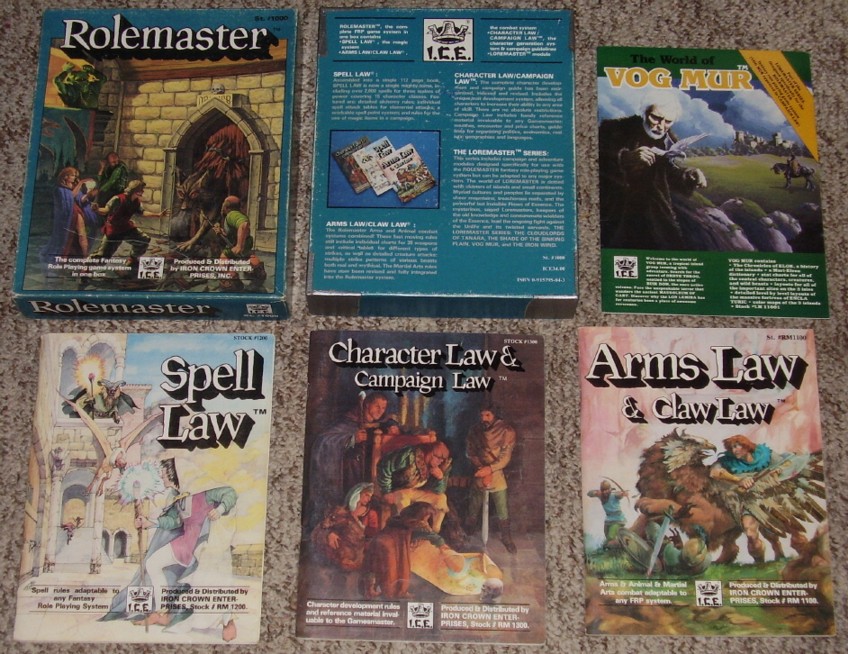
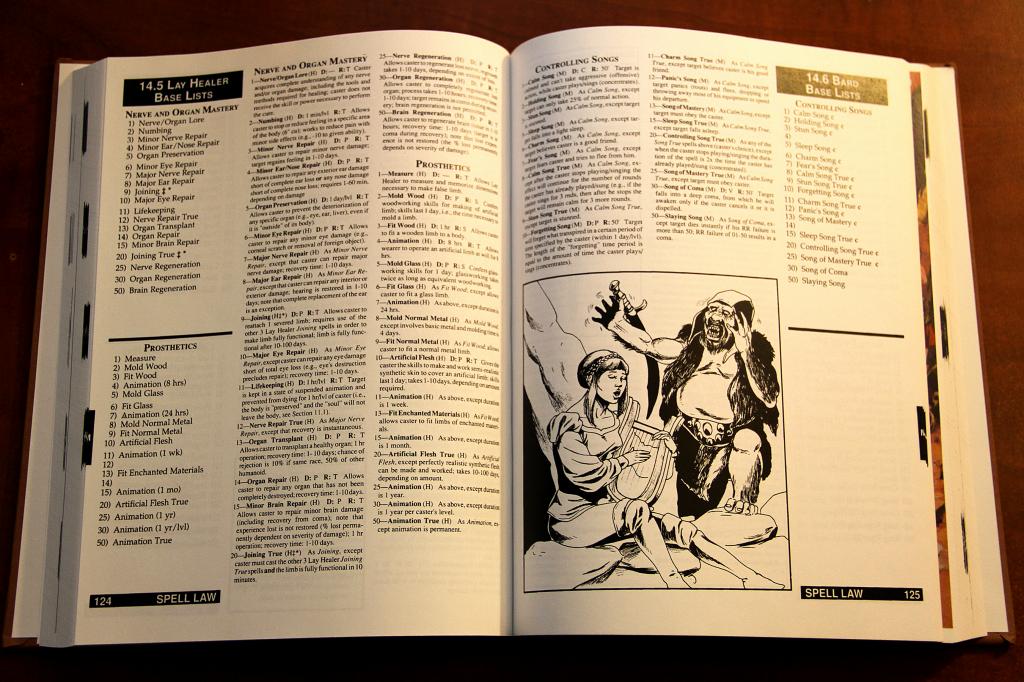
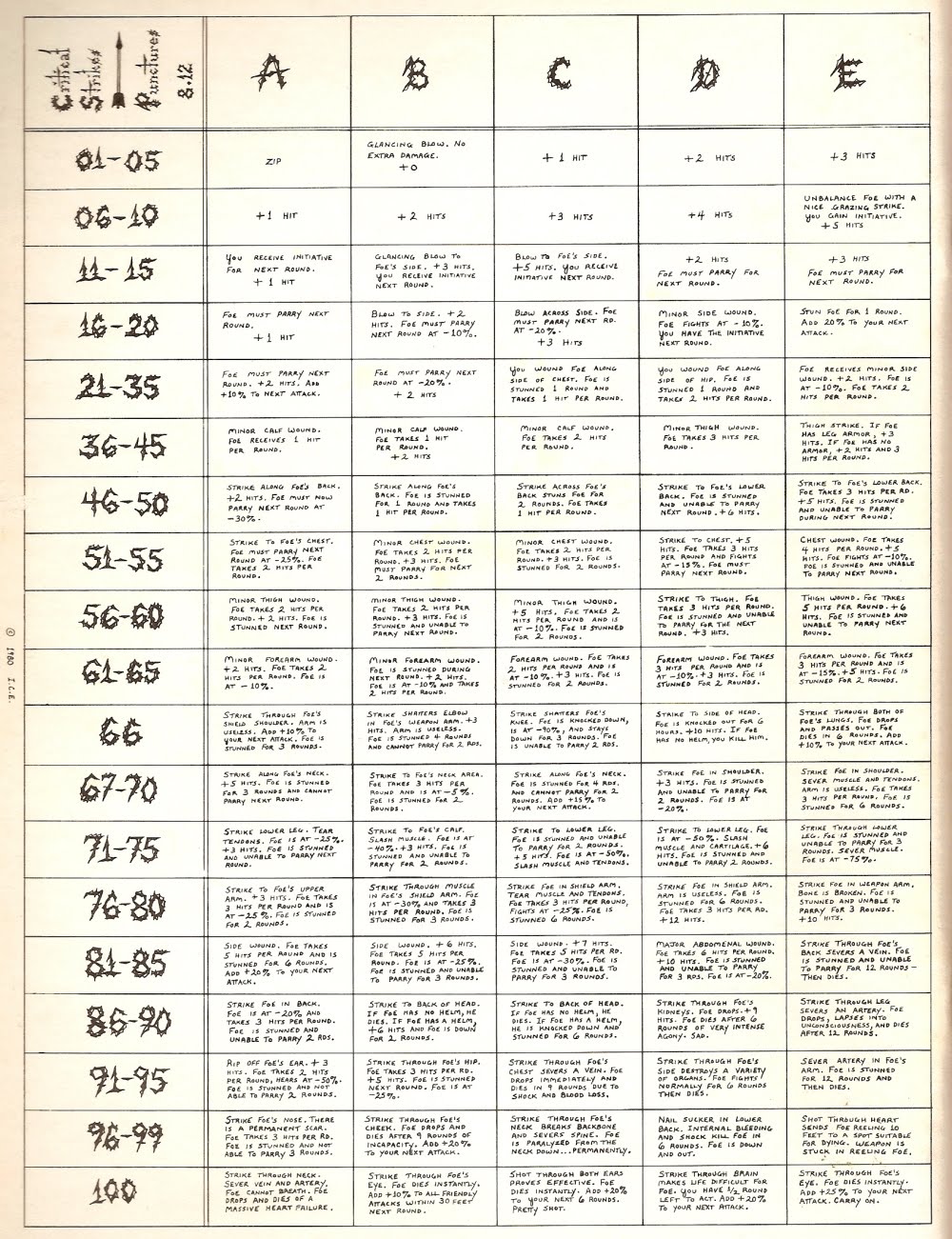
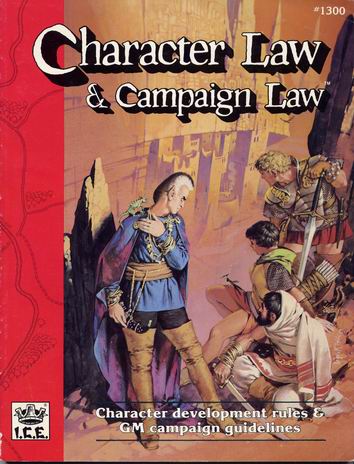
Oh yeah! Regan’s in the White House and New Coke tastes great! Put on your mirrored sunglasses, jean jacket with the air brushed dragon coiled around an 8-ball, and turn up that Man-O-War tape. I don’t care if your mom wants you to turn it down because you’ve got church in the morning. We’re talking Rolemaster, bitches, and we’re playing by I.C.E’s house rules.
---
History
From here: http://www.icewebring.com/what-is-rolemaster/
quote:
There have been four versions of the game produced, which fall into two major groups. First Edition and Second Edition Rolemaster belong to the first group, usually just referred to as RM2. There was then a fairly major revision to the game when the third version, Rolemaster Standard System was released (RMSS). This was then reorganized somewhat, with very few actual rule changes for the fourth version, Rolemaster Fantasy Roleplaying (RMFRP). Lists with cover images of the all the products for the various Rolemaster versions can be found at:
http://www.icewebring.com/ice-products/
The term Rolemaster First Edition (RM1) is generally used to refer to the products released between 1980 and 1982, the first versions of Arms Law, Claw Law, Spell Law, Character Law and Campaign Law. These were available as individual items and in various boxed sets. The original idea of these products was to replace portions of existing Roleplaying games (particularly Advanced Dungeons & Dragons) rather than being a stand-alone game on it’s own. However, once the full set of material was available, it was quite capable of being an independent game.
In 1984 the information in the books was expanded and revised, some of the books were combined and the material in them was rearranged. An initial boxed set was brought out in 1984 which resembled the previous Spell Law and Arms Law/Claw Law boxed set but contained a new Spell Law book and a combined Arms Law/Claw Law book but the older Character Law and the Vog Mur module.
A new boxed set was released shortly after containing three rule books and an Adventure module. The rule books were the combined Arms Law/Claw Law book and the Spell Law book from the previous boxed set and a combined Character Law/Campaign Law book. Several additional books were published from 1985 to 1988, including Rolemaster Companions 1, 2, and 3 and the first Creatures and Treasures book.
Technically, the products released between 1984 and 1988 are also First Edition Rolemaster products. The official start of the Second Edition Rolemaster series came with the Boxed Set containing the Arms Law & Claw Law book, the Spell Law book, and the Character Law and Campaign Law book, all with red-bordered covers.
However, other than a slight modification to the Combat Sequence and some rearranging of material, there are very few differences between the 1984 Rule Books and the 1989 Rule Books. This means that in most cases the term Rolemaster Second Edition (RM2) is used to refer to everything published from 1984 to 1994. In particular, Rolemaster Companion II included the Complete Skill Descriptions section and Master Development Point Cost Tables as well as several Professions that are often considered the distinguishing features of Rolemaster Second Edition.
With all the material that was published for Rolemaster Second Edition, it really became more of a method of developing a Roleplaying Game than an actual game itself. You could play in several different campaigns, all of them using Rolemaster, and they could all be quite different. It’s a matter of quite abit of debate whether that was the strongest point of RM2 or its weakest point. It made for a very flexible system with a lot of options, but could easily suffer from play balance problems if particular sets of rules were used together.
In 1995 the game was revamped and released as Rolemaster Standard System (RMSS). The biggest changes were to Character Generation, particularly in the number of skills available and the way bonuses for the skills were calculated. Skills were now grouped into Categories of similar skills and you could buy ranks (bonuses) separately in the Category and the actual Skill. Also the way combat rounds were laid out changed as well. The way Spell Lists were learned was changed and most of the Spell lists were adjusted and rebalanced. The actual method of doing attacks and figuring out damage did not change much, and there weren’t much more than cosmetic changes to the stats for Creatures and Monsters.
Like most changes, opinions on whether the changes were for the better or not vary widely, some people really like the changes, others are not so exited by the changes. To quote Smug (Adam) from the ICE Forums: "RM2 was the highpoint of the game of Rolemaster. RMSS and RMFRP are widely considered to be harbingers of the end of the world from a calamitous impact with a huge asteroid from outer space"
For the most part the objections to RMSS from RM2 players was more to do with not feeling that Rolemaster needed an overhaul and sadness that RM2 was no longer going to be supported rather than any major complaints about the system itself.
In 1999 the game underwent a slight restructuring when Rolemaster Fantasy Roleplaying was released, but this was mostly a rearranging of material with very few changes to the rules themselves. A detailed comparison of the RMSS and RMFRP systems can be found at: http://www.icewebring.com/rmss-vs-rmfrp/
Rolemaster Fantasy Roleplaying is the version of Rolemaster that is currently being sold and supported and thus is the version that is the easiest to get hold of and the one a new player is most likely to pick up. One of the changes made for this version was to come out with one book, stock number 5800 simply called “Rolemaster Fantasy Roleplaying” that can be purchased and has all the information needed to play the game.
You can choose from one of six Races and nine Professions. You can also choose one or more of the fifteen Training Packages to flesh out your character. There are equipment lists, a list of creatures, and ninety six spell lists, each containing descriptions of the spells up to tenth level. You get six weapon attack tables, one for each category of weapon. You also get the Tooth & Claw, Bash & Grapple, Bolt Spell Attack and Ball Spell Attack Tables. There are nine critical hit tables to go along with the attack tables and a Weapon Fumble and a Spell Failure Table. And, of course there are all the rules you need to use the tables as well as some sections on the basics of Game mastering and building a setting for your players to adventure in. A full review of the Rolemaster Fantasy Roleplaying book can be found at: http://www.icewebring.com/Reviews/RMFRPreview.php
There are several other core books that are recommended if you wish to expand upon the information in the main RMFRP book.
Arms Law adds additional Attack and Critical tables, replacing the condensed and generalized tables from the main book with tables that are more detailed and individualized for specific weapons. There are actually two versions of Arms Law that have been put out for Rolemaster Fantasy Roleplaying. A detailed discussion of the different versions of Arms Law for all the editions of Rolemaster can be found at: http://www.icewebring.com/docs/Arms_Law.pdf
Character Law adds additional races, professions, skills and the full talent and flaw system. A detailed review of Character Law can be found at: http://www.icewebring.com/Reviews/c..._law_review.php
There are three Spell Law books (Of Essence, Of Channelling, Of Mentalism),each of which adds additional professions and spell lists for one area of magic expanding the lists to 50th level spells.
If you are planning on being the GM for a Rolemaster Campaign, then you will want to make sure to get a copy of the Creatures & Monsters book as well.
If you have all the books listed above, then you have all the core material needed to play a full Rolemaster game. There are other excellent supplements as well, but most of them build upon the material presented in the books I’ve listed. All of the RMFRP books mentioned above are also available as PDF files from the ICE Website for about half the cost of the print books.
In this review, I’ll be covering the version I’m most familiar with, Rolemaster 2nd edition (“RM2”), which lasted from 1984-1994, most of which are pretty easy to find online through eBay or Amazon. This version lives on in the somewhat similar Rolemaster Classic, in the same way that AD&D 1st ed. lives on in Dark Dungeons, only you get to pay I.C.E for a physical copy of the books.
---
Now, as with many games and supplements from this period, the concepts of “comprehensible book flow” and “new player friendliness” were some far flung and bizarre ideas that never occurred to anyone working on the game. They all knew how to play it, after all. Thus, the first book you should read in the box, Character Law & Campaign Law, after a brief introduction to what RPGS are, spends 30 some pages boring you to death about the various ways you can die, how long it takes for your character to heal from wounds, poisons that can kill you, diseases you can catch, how moving will tire you out, and what things you can buy.
Seriously, check out this table of contents:
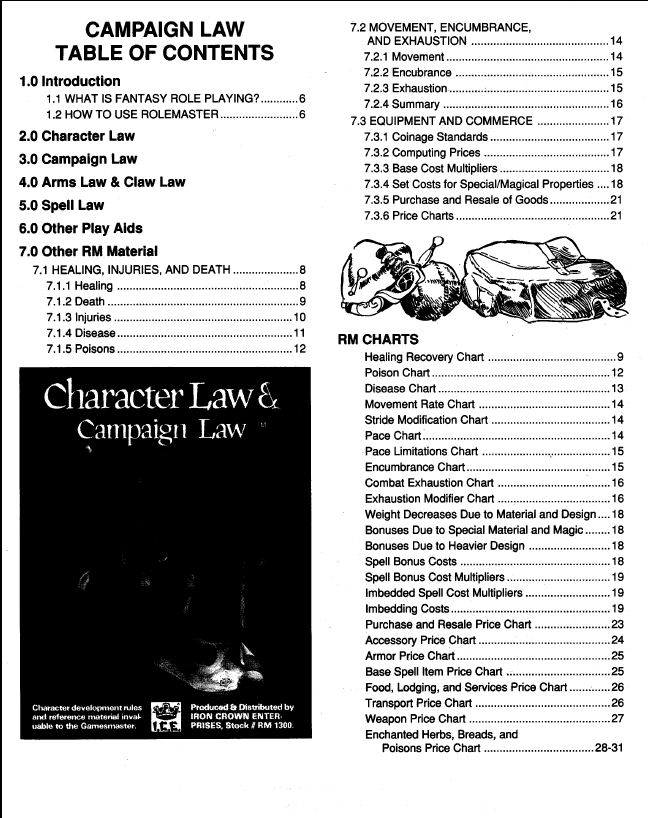
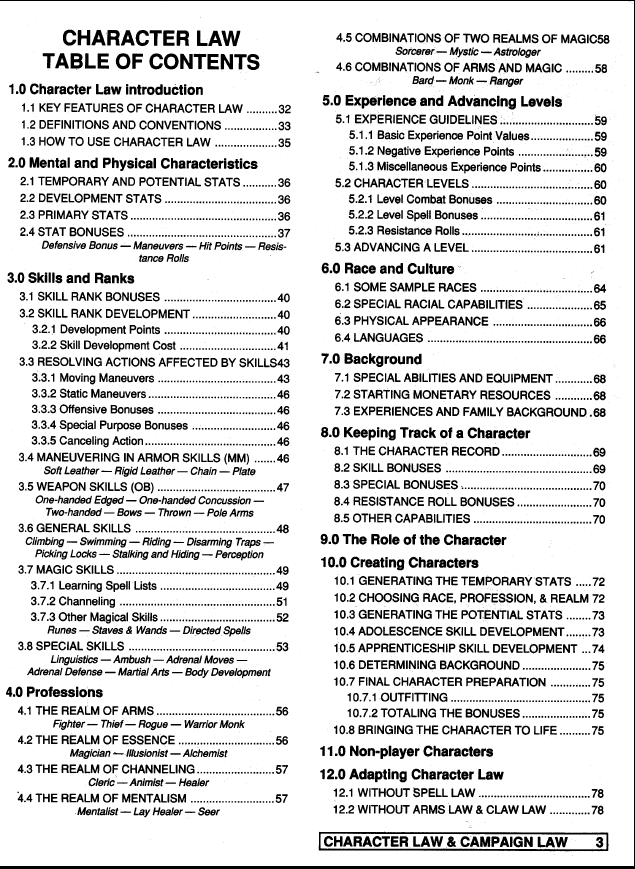
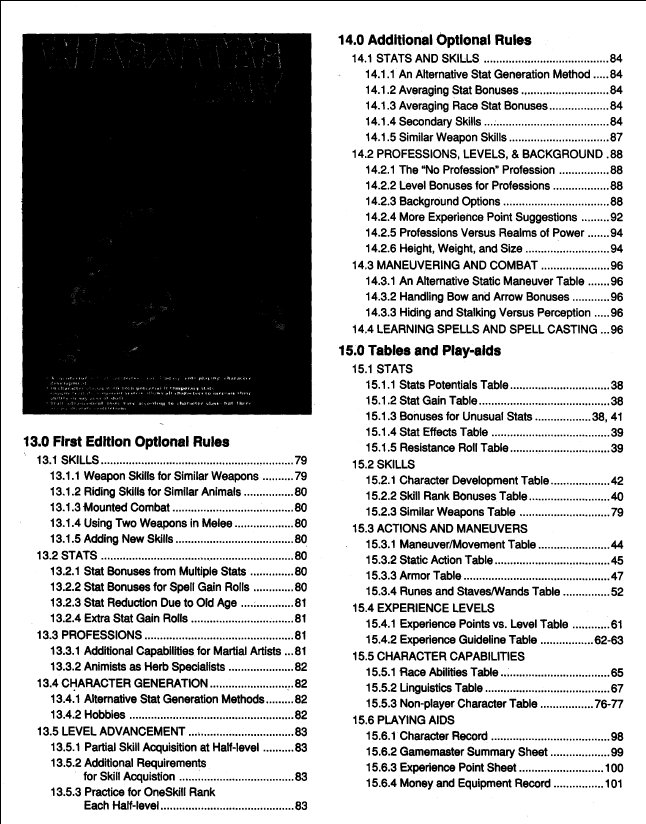
You’ll notice that we are supposed to learn about skills and gaining experience to level up before we cover how to generate a character.
Fuck. That.
Unlike many Fatal and Friends reviews, we’re going to tackle RM2 as a whole, focusing mostly on Character Law, Spell Law, Arms and Claw Law, and the 7 Companions, in an attempt to show how the game is actually played, not how a bunch of dudes in the 80s compiled their house rules together.
Think William Goldman’s The Princess Bride . This is Rolemaster: the Good Parts version, though we will be certainly be making fun of it a great deal for being a gog-mine of unnecessary awfulness when appropriate, and tearing it a new one where it needs one torn.
---
To begin, we’ll start with what they should have started with. Dice Mechanics.
Rolemaster is actually not that difficult a game. It is complicated , but it is not difficult. Reading Finnegans Wake is difficult. Understanding Heidegger’s concept of dasein is difficult. Calculating the ever changing weight-to-thrust ratio that will put a satellite into orbit around the Earth via multi-stage rocket is difficult. Doing some long addition, percentages, and cross referencing on charts is merely complex, and gets easier with repetition.
The basics of Rolemaster are as follows: roll a d100, add your relevant skill, add or subtract any modifiers, and check against the difficulty to see how well you succeeded or failed. If you roll 96-00 (“open ended”), roll again and add that new roll, and if you rolled another 96-00, do it again, until you roll a 95 or lower. If you rolled a 01-4, roll again and subtract the number from your skill.
At its core, no more difficult than d20, eh?. Forum favorite Monte “The Moon” Cook was a big Rolemaster guy in the 90s, before he hit it big, and a lot of his fingerprints are all over this game, as we’ll see when we get into classes.
Mostly what you'll be doing with the dice are maneuvers and combat. We'll cover combat in the third part of our review, but let's tackle skills now to show how the die system works.
There are two types of skill maneuvers, static or moving. Static are things like picking a lock, remembering the king’s favorite book, hitting on a barmaid, and other things that generally won’t result in you tripping over and killing yourself. Moving maneuvers are everything that can result in you tripping over and killing yourself.
To succeed on a static maneuver, you need to roll over 100. The modifiers added or subtracted have to do with the difficulty or ease of the task. For example, a cheap skeleton key lock giving you a +20 to crack it, while a master-crafted Elven puzzle lock that relies on Sindarin puns to open might give your human thief a -70. Unsurprisingly, there is a chart for this, which details common situations for each skill (Difficult locks, good illumination to sneak past, how much damage you’ve taken, etc.) and what penalties to assign. Or you can just make them up on the fly, like a good GM.
To succeed on a moving maneuver, you must check our first big chart:
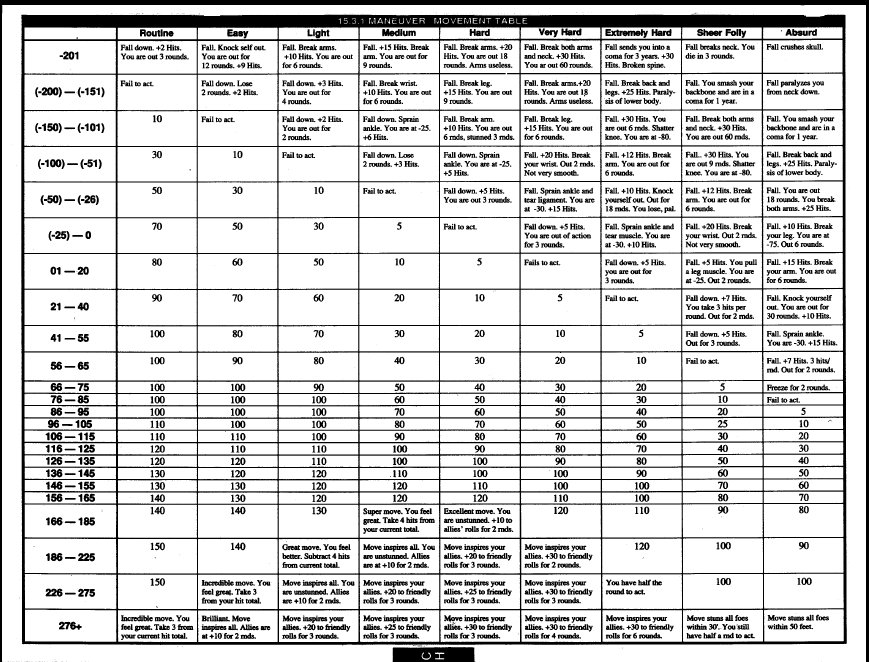
Now, I can already hear you crying “HOLY FUCK NO! LOOK AT THAT THING! YUCK!” but I swear it’s not really that bad.
Now, how do we set difficulties? See that list of adjectives across the top? The GM will have assigned the maneuver you want to do a difficulty of somewhere between “Routine” (A trained acrobat making a 5’ jump) and “Absurd” (a fat out of shape guy doing ninja moves). The GM decides which one what you’ve just described is, and tells you how difficult is it. You then have the option to try something else, or attempt the action. You then take your roll with all its totals and cross reference it against the difficulty column you were assigned. The number is what percentage you have succeeded by.
The above examples with numbers, Pierrot Lunaire, master acrobat and thief, is escaping from the palace with the royal jewels. He wants to leap the chasm between buildings. His jumping skill is a masterful 82. The distance between rooftops is only 10 ft., and he has a running start, and really this sort of thing is old hat for a guy like this, and he’s not being chased by the guards or anything yet (he made his Stalk & Hide rolls earlier), so the GM rules that this is a Routine leap. He rolls a 40, for a total of 122. Checking the chart, he succeeded with 120% success, easily clearing the gap with room to spare and continues his silent disappearance into the night without any trouble.
On the other side of town, 300 lbs. Albert von Goonovitz is trying out the skills he learned from the ninja wall climbing YouTube videos he watched earlier to break into Lauren Faust’s house to steal her pony drawings undetected. He has no training in the climb skill, which gives him a penalty of -25, and his Agility stat isn’t very good (only a +5), so Albert is starting off with a base modifier of -20. The GM thinks that an out of shape man with no athletic prowess silently stealing things is Absurdly difficult, and tells the player so, but Albert’s need for original pony art will not be undeterred, so he tosses his hook and begins his ascent. He rolls the dice, and gets a 96! He rolls again, and gets a 42. Subtracting the -20 he has for being an unskilled, overweight klutz, Albert has a 122, the result the Pierrot had when he was stealing the jewels in our last example. Surely our corpulent cat burglar will have his ponies tonight! But wait, the GM ruled that this was an absurd maneuver. Checking the 122 against the “Absurd” column, we find that Albert has only succeeded at 30% of his maneuver. The GM rules that he gets about 1/3 of the way up the rope before his huffing and puffing awaken Ms. Faust and the loud racking of her shotgun means that combat will surely begin soon.
One of the nice things about the system is that there’s always a chance you’ll succeed, small as it may be. The odds of rolling a triple or quadruple open ended are really really slim, but I’ve seen it happen.
---
Next Time : Monte’s Dream, or many of the character classes are either traps or designed for anal retentive GMs who need to extensively stat out every NPC for some reason.
What I need from you : Two stock fantasy characters. We’re going to make two different characters to show how the character creation system works, and how easy it is to fall into traps and make a completely unplayable one if you’re not careful. We can make pretty much anything, provided it falls onto the usual Human-Elf-Dwarf-Hobbit-Half-Orc spectrum of races, so beyond that don’t be afraid to suggest something crazy. I'm sure with a little poking around online you can find a list of the various professions available in RM2, if that's your thing.
Rolemaster is dangerous in its flexibility.
Character Creation, Part One: “Yesterday They Were Businessmen. Today They’re Cowboys. Tomorrow They’ll be Walking Funny.”
Original SA post
Part 2 - Character Creation, Part One: “Yesterday They Were Businessmen. Today They’re Cowboys. Tomorrow They’ll be Walking Funny.”
Character creation is an involved process, with more than a couple charts. It is harder than AD&D or 4e, but a bit simpler than Champions or GURPS, straddling about the midpoint between GURPS and 4e for me personally.
First up, appropriate music:
http://www.youtube.com/watch?v=Kl1rroJOZzw
Yeah, alright. Now that’s some Tolkien inspired German power metal to do math to, alright.
We start with the 10 different Character Developmental Statistics (“stats”):
Constitution - affects your starting
Agility - affects ranged combat, maneuvering in armor, contributes to melee combat, and other movement based skills.
Self-Discipline - affects meditating, being a zen master, avoiding temptation, and sneaking.
Memory - affects memory based skills and learning.
Reasoning - affects wisdom and thinking based skills.
These five stats each contribute to your Development Points (“DPs”) pool. You will spend these points to buy skills, which cover everything from swinging your sword, having hit dice, casting spells, and wearing armor, to knowing who the king’s long lost brother was or identifying different types of trees from very far away.
Strength - affects melee combat, your carrying capacity, and skills like climbing, playing sports, doing martial arts.
Quickness - affects your movement rate, gives you your innate defense bonus, and contributes to a couple skills that involve running.
Presence - affects your spell casting if you are a Mentalism (“Psionics”) realm caster, your skills having to do with charisma and social interaction like acting or lying, and gives you a bonus or penalty to resistance rolls against mentalism spells.
Intuition - affects your spell casting if you are a Channeling (“Divine”) realm caster, your skills involving knowing things before they happen, like perception, dowsing for water, and divination, and gives you a bonus or penalty to resistance rolls against channeling spells.
Empathy - affects your spell casting if you are an Essence (“Arcane”) realm caste, your skills involving relating to other people or animals, like anthropology or animal husbandry, and gives you a bonus or penalty to resistance rolls against essence spells.
There’s also the super special optional stat Appearance, which doesn’t really do anything outside of roleplaying. A buddy of mine played a caster specializing in fire magic with an appearance of 01. We quickly nicknamed him Handsome Jack.
Unlike in D&D, there are no obvious dump stats. You can get away with a dumb fighter or a weak caster, but between the amount of gear you want to carry, the shit you need to know to survive, and the bonuses you’re going to want against spell casting, you can’t safely tank any of the stats. In terms of priority, the stats that affect how many DPs you get are a bit more important, because dumping them mean that your character will get fewer skills overall, but if drop the others you’ll leave yourself either completely vulnerable to one of the three schools of magic, always go last and get hit easily, or be unable hit things and carry back any treasure from the dungeons.
Unfortunately, this isn’t a perfect world, and you are at the mercy of the dice to determine the numbers you get to assign. Without cheating or really good luck, there is no way to make a character that doesn’t have some hole or gap you’ll really want to fill. Such is life.
To generate the rolls, we’re going to be generous. Our house rules are as follows: roll 3 sets of 10 stats, rerolling any number under 40, chose the best set, and arrange as you chose. The book wants you to just roll once, rerolling any under 20s, and assign as you like, but we’re big enough children to understand that we want to play fun characters, our verisimilitude won’t be destroyed if Conan, Aragorn, Merlin, and Hercules are all at the same table together, and besides, the original stats chart is kind of a fucked up bell-curve so it doesn’t hurt to aim yourself towards the 90s with those rerolls.
Here’s what the better stat bonus chart looks like:
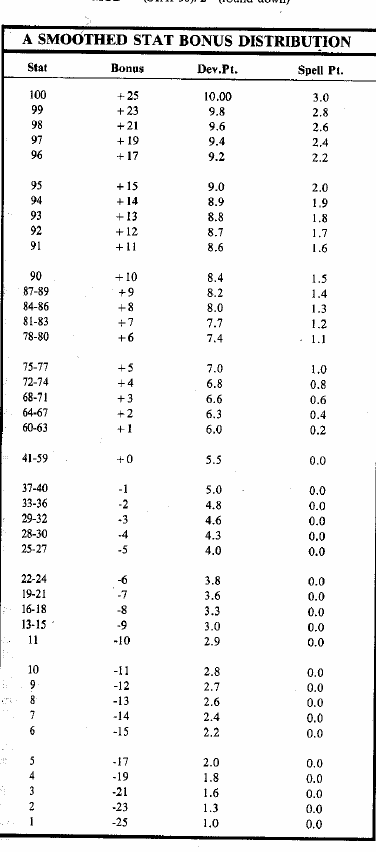
This is the smoothed stat curve from RMC1, which evens out the bonuses a little bit.
The original formula from Character Law for calculating the bonuses is “Stat - 50/2 rounded down”, which means that over half the numbers (25-74) give a bonus of +0, which really kinda stinks. There are ways to deal with that, though, and a low roll on the initial set of states doesn’t necessarily doom your character forever. We’ll talk about that in a moment.
code:
Set 1: 52 41 99 59 40 51 62 90 56 56
Set 2: 87 70 79 72 87 67 60 59 95 46
Set 3: 42 91 46 62 47 45 60 97 72 99The most important thing you will learn when making a character is that You Will NEVER have enough Development Points to do everything you want to.
Anyways, lets look at our rolls again. The numbers we rolled are our temporary stats, and they represent how our character is right now. After we stick them into our attributes, we’ll roll on the Stat Potentials Table to see what the maximum possible stats are for our character. This means that every stat will have a temporary value, the one you’re using to calculate your skills right now, and a potential value, which is the maximum it can go without special help.
Each time you go up a level, you’ll go down the line on your skills, rolling on the Stat Gain Table and cross referencing the difference between your temporary and your potential values to your die roll to see how much your stat went up by. If you rolled a 01-04, the temporary values instead goes down by the number that you rolled. Some monsters and poisons and stuff can also reduce your temporary stats, but when you gain another level, you’ve got a chance of them going back up towards their full potential.
The potentials table is geared towards making it much easier for character with low numbers to grow into high ones, and characters with high starting stats to just stay that way, so starting with a series of low rolls doesn’t necessarily mean you’re completely boned. There’s also a skill you can buy to raise your stats, but it’s pretty expensive, so we’ll save that for when we cover leveling up.
---
To show off how the rest of character creation works, we’re going to build some sample characters, which will probably take the next post or two. And you know what, fuck it, I know I said two, but we’re making four characters, and mashing up some of your suggestions to really show y’all what the system does. The first will be the most involved, going through every step of the process in full detail, with the next three touching on bits like spell casting realms, trap options, bad professions, etc.
Zereth posted:
Make as Invincible an Invincible Sword Princess as you can in Rolemaster.
Siivola posted:
A humanprinceprincess, the very image of a chivalric knight-errant in shining armor, well-versed in arts both martial and otherwise.
Ser Diana of Steece, the Hyena of the Battlefield, is level 1 high-man Cavalier. We want her to be able to bash things with an axe, slay dragons, raid dungeons, ride a horse, know the history of her people, and seduce handsome bartenders.
Let’s lay out her stats. Being a warrior type, we want Diana to be strong and tough, but because of how we’re picturing the character we want to play, not stupid or uncharismatic.
code:
Co: 42
Ag: 97
Sd: 45
Me: 72
Re: 46
St: 99
Qu: 62
Pr: 91
In: 60
Em: 47Now, you may have noticed that I stuck the 42, our lowest roll, in Constitution. Isn’t Co terribly important for a warrior type? Yes, definitely, and I’ll explain why we did this in a moment.
For a race, since she’s a noble woman, we’ll make her a high-man.
Racial modifiers are a little bit different than in most games. Rather than providing a raw +2/-2 to a pair of stats, they instead provide a series of bonuses and penalties to the stat bonuses , not to the temporary or potential stats themselves. Being a high-man gives Diana a +10 to her St, Co, and Pr, and -5 to her Qu and Ag. Looking at the race chart, she’ll be using a d10 for hit dice, will have a maximum of 150 hit points, will start knowing 3 languages, and will get 4 background rolls.
Now that we have our stats laid out, we’ll chose a
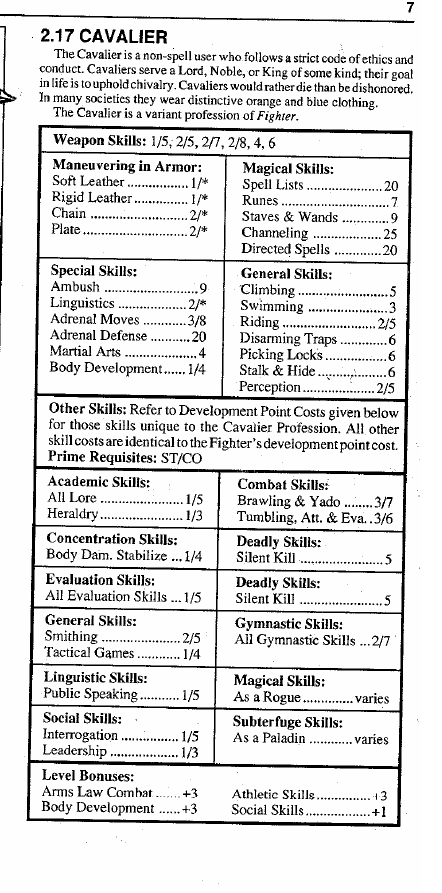
Starting with Companion 1, they stopped putting professions into one big unwieldy chart, and started putting them into a nice box, with some references to the old charts. With companion 2, it got a even easier, because the boxes stopped being 90% “Look at the master development point chart”. Unfortunately, they never went back and put the old original classes into nice boxes like this, so if you want to play a straight fighter or magician or cleric, you’re stuck using the big chart. C’est la vie.
Each profession has a pair of stats as their Prime Requisites. These are the two most important stats for the profession, and if the player chooses, they may replace whatever die roll they put into the stat with a 90. This is nice because it means that, no matter how badly you tank your die rolls, you can stick your two worst rolls into your Prime Requisites and be alright at your chosen profession. Now, because we rolled pretty good, and because we’re going to be doing a lot of killing, we’re going to want our warrior princess to have that 99 in St. But a 90 in Co is just fine since we’re going to be wearing pretty heavy armor to help soak up hits. So we can scratch off that 42 and replace it with a 90.
Character Sheet Check:
code:
Diana of Steece
Level 1 High-Man Cavalier
Temp Pot. Bonus Race
Co: 90 90 +10 +10
Ag: 97 97 +19 -5
Sd: 45 83 +0
Me: 72 72 +4
Re: 46 80 +0
St: 99 99 +23 +10
Qu: 62 74 +1 -5
Pr: 91 91 +11 +10
In: 60 60 +1
Em: 47 72 +0Each rank in a skill give you a +5 bonus, for the first 10 ranks, then each one give you a +2, until you hit 20 ranks, then it’s a +1 until you hit 30 ranks, and then it’s +1/2 ranks forever. Warrior professions, like the cavalier here, have a slight difference in that their combat skills go +5/+4/+2/+1, to represent just how much better they are in combat than other professions.
Unlike many other games, there is no such thing as a “class only” skill, merely skill that cost an awful lot more or less development points depending on what profession you are. You may have noticed that, even though she's a warrior, Diana could take “Spell List Acquisition” as a skill and learn to cast some spells, but it would cost her a hefty 20 DPs for one rank. As we only have 36 DPs to spend per level right now, we’ll leave that trap option alone for the moment. That’s one to use when you’ve reached higher levels and your options are “spend points to get an extra +0.5 to add to my already +300 basket weaving skill” or “learn some of a spell list”. It’s not for new characters like us. That is, of course, different for spell casters, whose SPA skill costs them 1*, or semi-spell casters, who are 4*. The difference between 20 and 1* is a yawning chasm.
Before we spend any DPs, we should roll on the Backgrounds chart to see what bonuses we get. Each race gets a number of rolls on the charts to balance out how big their bonuses are. The mixed men and dark tribes get a lot, because their stat bonuses aren’t super great, while the half-elves and high elves get very few because their bonuses are awesome. As a High-man, Diana is entitled to 4 rolls, which is middle of the road.
There are two different charts, found in Companion 1, and mostly they provide additional stat bonuses. 1-10 are penalties. 11-40 are fun background buffs. 41-00 are stat buffs. There are a bunch of other charts throughout the various companions that will allow you to start with magic items, or a bunch of trade off kinda buffs “You are farsighted, giving you a bonus to ranged combat, but take a penalty to learning to read and write”, but I like these two charts best.
Rolling 4 times on the “Skill at Arms” table (the “Skill at Magic” one wouldn’t do us much good as a non-caster), we receive the following bonuses:
37. “Eye of the Tiger” - The PC can prepare the Adrenal Strength maneuver with a slightly modified difficulty to gain a bonus to attacks and defenses next round (paraphrasing here because the specifics don’t matter right now, as we can't really use this until we've gained a couple levels).
44. +15 Ag
17. Natural Faculty With Armor - All armor development costs are cut in half.
98 +20 St.
This is a pretty sweet set of bonuses. Ag and St are the lifeblood of most Fighter types, the 1/2 cost armor skills is going to save us a ton of DPs, and the ability to charge up our attacks with a skill check could be good once we get enough ranks to activate it well.
Next, we’ll total up our development points, and spend them on skills. Totaling up our development point granting skills, we come to a total of 35.6, which rounds up to 36.
At level 1, to represent the slog from adolescence to adulthood, we are actually supposed to start by building a level 0 character, then leveling them up to level 1. What this means in practice is that you get double the DPs at level 1, and can buy two ranks of any skill you like before paying extra. Any GM weird enough to do the math required to say “Hey, you spent this set of numbers incorrectly, therefore you didn’t do your level 0 correctly!” is probably not a person you want to play with.
Because Diana is a fighter type, weaponry is going to be her most important consideration. Looking at the big box, we see that weapon skills is followed by 6 numbers. We get to assign these numbers to the 6 weapon categories that Rolemaster has: 1-handed slashing, 1-handed crushing, 2-handed, polearms, bows, and thrown. Once we’ve assigned costs to the broad categories, we’ll then buy ranks in the weapons. Diana here likes axes, so we’ll put her 1/5 in 1-handed slashing, and spend 2 DPs to buy 2 ranks in it.
To calculate what her skill in Axes is, we’ll take the stats that 1-handed slashing runs off of (the average of her st/st/ag is 45), add that to her skill bonus (2 ranks is a +10), but there’s one more thing to take into account.
If you look down at the bottom of the big box, you’ll notice a section marked Level Bonuses. Each skill is divided into a certain category, and you get a bonus to certain categories each level just for being in the class. Diana gets an additional +3 to arms law combat for being a cavalier.
45 + 10 + 3 = 58. For a level 1 character, she can kill things with axes really well.
Now, if we wanted to, we could sink another 5 or 10 points into her Axe skill and have her be even deadlier, but we still have a lot of other things we need to buy. One of the nice things about the Rolemaster system is that the things you want your character to do (your fighter to swing swords, your cleric to cast spells, etc.), they get to do at a pretty severe discount, so you’ve got points left over to do other things.
Next up on the list is hit dice, which Rolemaster calls “Body Development”. Being a fighter type, Diana should expect to get hit, and take damage, and she’ll need concussion hits to soak that up. Because she’s tough, she can buy them at 1/4. For comparison, a paladin pays 2/5 for his body development, and a magician 8. We’ll buy 2 hit dice, which gives us 2 d10 to add to our base HP, and the bonus +3 we get from the cavalier level bonuses.
After that comes armor. In Rolemaster, anyone who wants to can wear a suit of armor, and said armors are divided up into 20 categories. Each of these has a description and a set of penalties associated with it, which we’ll go into in greater detail when we get into combat. Right now though we’re just going to look at the chart:
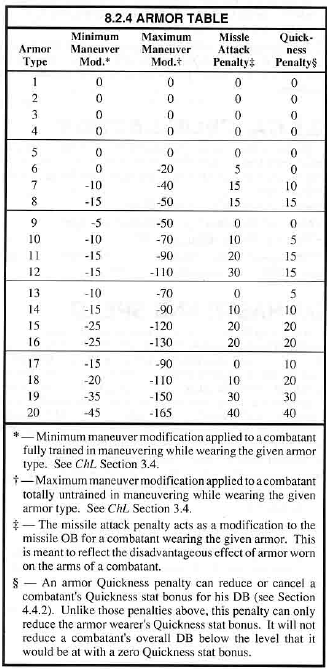
When you wear a suit of armor, the maximum maneuver penalty is applied to all of your movement maneuvers. This is to represent how difficult it is to jump around in a suit of heavy armor without practice. As we all know, historical knights trained night and day in their armor, and were able to do cartwheels and leap onto their horses from the ground in full plate. Just because Jason Bulmahn can't do it with a couple hours practice doesn't mean it's impossible. To represent this, there are a series of skills, Maneuver in (type) Armor, that reduce these penalties for each rank we purchase in them.
17-20 are the heavy armors, your steel breastplates and plate mails, and since Diana is a knight in shining armor, that’s the range we’re looking at. This category falls under the skill “Maneuver in Plate Armor,” and ordinarily she would need to pay 2 DPs for each rank in the skill she bought. But because we rolled that cool background, we get to cut that number in half and only pay 1.
Time for a little calculation: At 1st level, we probably can’t afford a full set of plate of half-plate, but the AT 18, a steel breast plate with greves is well within our budget. The maximum penalty for AT 18 is 110, which is basically an auto fail for any maneuver, so we definitely want to buy that down. The minimum is 20, to represent that wearing an extra 20 lbs of metal on your body is going to affect your poise and grace a bit, and we don’t want to overshoot it and spend too much. That’s a difference of 90, which is 18 skill ranks. But before we drop in 18 DPs, let’s double check our stats. Maneuver in Plate is an Ag based skill, and a combat skill, so we start out with a pretty good bonus even if we just put one point in (untrained skills are at a -25, so our untrained base of 7 (29 ag + 3 level bonus - 25 untrained) jumps to a 37 with just 1 rank). Do a little math, and we’ll find that 12 ranks hits 90 right on the nose, putting us exactly at the minimum penalty for AT 18 (110 - 20 = 90).
We’ve spent 16 of our 72 DPs so far, and we’ve already got kill things, wearing armor, and not dying covered. What else should we be able to do?
It’d be nice to have some ranged capabilities, so we’ll assign our 2nd weapon category to “bows” and put 2 ranks into Crossbow, which we can use without worrying about the missile attack penalty from armor. This costs 4 points.
We’ll also buy two ranks in Brawling, in case we’re ever caught without an axe handy. This makes more sense than martial arts, because she’s not a kung-fu princess or something, and also lets us fight with broken bottles, chair legs, shoes, and other Corwin of Amber type shit. Brawling isn’t listed in the Big Box, so we need to look it up on the Master Development Point Chart, which is a pain in the ass, but we find that it costs 3/7. Six points well spent. 26 of 72, and we’re done with combat. We haven’t even spent half our points, and unless we really want to sperg out and also make her a sword mistress and poleaxe pundit, we’re ready to buy other things.
Because she’s a big brawny athletic girl, Diana is going to be good at swimming, jumping, tumbling, and acrobatics, and it’s worth it to buy at least a single rank in those skills to offset the -25 penalty for having the skill untrained. This costs us 9 points total.
She wouldn’t be much of a cavalier if she couldn't ride a horse, so we’ll of course buy 2 ranks in riding, and 2 in animal handling. These cost both cost 2 a rank, so we’ve spent another 4 DPs here.
Cavaliers get Lore skills as a pretty good discount, 1/5, so we’ll pick up a rank each in Demon Lore, Dragon Lore, Demon Lore, Fauna Lore, Herb Lore, and Undead Lore. 6 points total, and we’ll be able to tell one monster apart from another. We aren’t amazing at any of them, only a +9, but that’s much better than the -24 we had before, and having ranks in the skill gives the GM justification to adjust the difficulty downwards towards light and routine on our maneuvers.
We’ll then learn a little about the history of our people (Racial History: High-men), Military Organization, and Leadership, all of which are things any warrior princess should know, and which cost 3, 1, and 1 respectively. 49 points spent, 23 left.
Because we want to survive our adventures, we’ll buy 2 each ranks of General Perception, Sense Ambush, Body Damage Stabilization (one of those system mastery picks, which allows your character to put themselves into a kung-fu master coma if they take too much damage and stay alive while waiting for medical attention), and Detect Traps. That’s 10 points spent. Because I’ve got a bit more system mastery in me, I know to buy ranks in Stunned Maneuvering, which allows you to overcome one of the most common conditions in combat, so we’ll spend another 4 points to get 2 ranks of that. 9 Left.
Because she’s not just some shallow combat monkey, we’ll buy 2 ranks in Music, allowing her to compose symphonies with a rather skillful +40, and a rank in Streetwise so she can fence the magical goods that her adventuring party keeps being back up from the dungeons.
We’ll roll our 2d10 for gold, spend it on equipment, and we’re good to go.
code:
Diana of Steece
Level 1 High-Man Cavalier
Temp Pot Bonus Race Bkgd Total
Co: 90 90 +10 +10 = 20
Ag: 97 97 +19 -5 +15 = 29
Sd: 45 83 +0 = 0
Me: 72 72 +4 = 4
Re: 46 80 +0 = 0
St: 99 99 +23 +10 +20 = 53
Qu: 62 74 +1 -5 = -4
Pr: 91 91 +11 +10 = 21
In: 60 60 +1 = 1
Em: 47 72 +0 = 0
Skills:
Combat:
Axe (st/st/ag)- 2 ranks = + 58
Crossbow (ag)- 2 ranks = + 42
Brawling (st/st/ag)- 2 ranks = +58
Maneuver in Plate (ag) - 12 ranks = +90
Stunned Maneuvering (sd) - 2 ranks = +13
Academic
Demon Lore (me/re)- 1 rank = +9
Dragon Lore (me/re)- 1 rank = +9
Fauna Lore (me/re)- 1 rank = +9
Herb Lore (me/re)- 1 rank = +9
Racial History: High-Men (me/re) - 1 rank = +9
Military Organization (re/pr) - 1 rank = + 16
Undead Lore (me/re) - 1 rank = +9
Athletic:
Acrobatics (ag/qu) - 1 rank = +35
Jumping (ag/st) - 1 rank = +64
Swimming (ag) - 1 rank = +37
Tumbling (ag/sd) - 1 rank = +37
Concentration:
Body Damage Stabilization (sd/em) - 2 ranks = +10
Linguistic:
Music (ag/in) - 2 ranks = +40
Outdoor:
Animal Handling (pr/em) - 2 ranks = +31
Riding (ag/em) - 2 ranks = +39
Streetwise (pr/in) - 1 rank = +27
Perception:
Detect Traps (in) - 1 ranks = +10
General Perception (in/in/re) - 2 ranks = +11
Sense Ambush/Assassination - 2 ranks = +11
Social:
Leadership (re/pr) - 1 rank = +17
Special
Body Development 2 ranks
Because of the way the skills are calculated, it can be a bit of a pain to do them on the fly. You have to do the average of the skills, plus any applicable level bonuses, then the subtraction for the untrained penalty. What these huge character sheet guys are doing is printing out every skill in the game, with their character’s current modifiers already calculated. My present GM has put together a pretty nice Excel sheet that comes to about 9 pages long when printed, and does contain all the skills calculated properly. It does save a lot of time not needing to do the math for each skill, but sometimes seems like a waste of paper and ink when 90% of the skills will never, ever see use in a game.
A roll on the height/weight chart tells us that she stands 5’9”, with a heavy build, and therefore weighs 190 lbs. It's all muscle, though, so don't go calling Shine and the YLLS crew. Punching numbers into the encumbrance algorithm, we find that Diana has a weight allowance of 19, which is 10% of her own weight, and because her St bonus is +53, she can carry up to 8x that without any penalties. Our girl can lug around 152 lbs. of treasure without breaking a sweat, and is operating at only a -17 to maneuvers when lugging around her full body weight. She’s a fucking brick. A Qu of 62 means she can move 55’ a round, which is dead center average.
Now, after all this, we reach something that sounds like a neat idea on paper, but is actually kinda dumb in practice. The game wants you to “pre-level-up” to level 2, spending all your DPs in advance, but not changing the numbers yet, to represent the things that your character is working on in the period between this level and the next. It’s a cool idea, I’ll grant, and kinda realistic in that it prevents the guy who just found the spellbook and levels up from saying that he’s read it and is now buying ranks in Spell List Acquisition immediately. Unfortunately, in practice, it’s a lot of unnecessary bookkeeping and no one at my table really cares enough to take the game that seriously. So we’ll skip this step and roll for hit points instead.
We’ll roll out 2d10 for hit points, add that to our base hit points of 12 ( 1/10 of your Co, so 9, + her body development level bonus of +3). I rolled a 4 and a 6, so she starts with 23 hp.
We’ll then spend our gold on a battle axe, some AT 18 armor, a full shield, some healing herbs and beef jerky rations, a sack to put treasure in, and a riding corgi to head into battle upon.
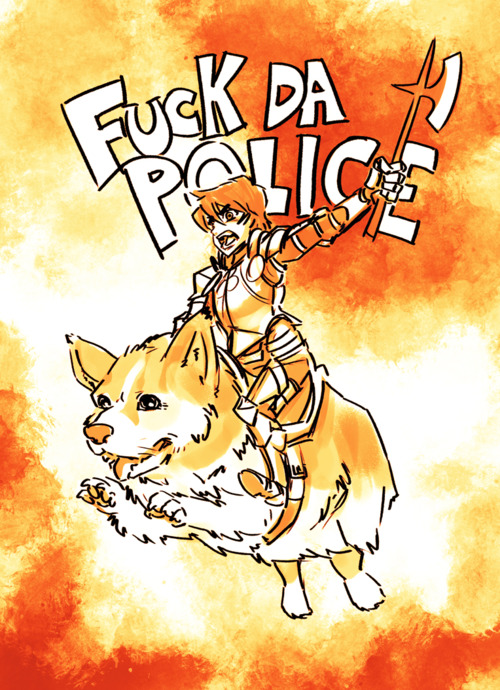
Next Time, Casters and Traps, they aren’t always the same thing!
How the hell do you make a character, part 2: The Legend of Curly’s Gold
Original SA post
Part 3 : How the hell do you make a character, part 2: The Legend of Curly’s Gold
Last time we went through all the steps involved with making a character. It was an involved process, what with all the different formulas and tables that went into calculating how your skill modifiers were determined and the differences between temporary and potential stats, but what we left out was a major aspect of all fantasy gaming: Magic.
Spell Casters are divided into three broad categories in Rolemaster: Pure, Hybrid, and Semi.
There are three realms of magic in Rolemaster: Essence, which is your arcane spelling slinging magician type magic, Channeling, which is your divine undead turning type magic, and Mentalism, which is your psionic brain exploding type magic. Spell casting is run off of a Power Point (PPs) system. Each Realm keys off of a Stat, which in turn gives you a number of PPs per level. There are magical items which will multiply the number of PPs you get, as well as items known as “Spell Adders,” which give you a number of free spell castings, regardless of cost, X number of times per day.
A Pure spellcaster will specialize in one and only one realm. A Hybrid spellcaster will mash-up two realms, with some DP cost penalties for this lack of specialization. A Semi spellcaster will mash-up any one realm with the realm of Arms (non-casters), providing your professions which are adept at both fighting and spell casting, like Rangers and Paladins.
Casters get their spells by taking a skill called “Spell List Acquisition,” which they get at a supreme discount when compared to non-spell casting classes (remember that there are no “class exclusive” skill in Rolemaster; anyone can take any skill they want). For Pure and Hybrid casters, this skill will cost 1*, and for Semis it costs 4*.
According to the rules as written, you are only allowed to take Spell List Acquisition for one spell list at a time, and each time you level up, you make a check, adding you SLA skill ranks to your casting stat bonus, and if your result is higher than 101, you learn the list. If it is less, then you must wait until the next level before trying again. As a house rule, my group always let you work on multiple lists at a time, because really, having to wait until at minimum level 10 before you even got all your base lists seemed needlessly penalizing to an already difficult to play series of classes.
Spells are divided into thematic lists, which go from 1-50, and are divided into three different categories (noticing a theme here yet?): Base, Open, and Closed. Base lists are class specialities, the things that a particular class does best and can only be learned with great difficulty by other classes. Open lists are the easiest tricks of that particular realm, and anyone can learn them. Closed lists are the more difficult spells that, while any pure caster can learn them without trouble, others will have some trouble. Each spell costs a number of power points equal to its level to cast.
Spell Law boasts that it contains over 2000 spells, which, well, you already know if you're the target audience for that kind of thing or not. The lists are very specific, with separate lists for healing bones, muscles, organs, and building magic prosthetic limbs, separate lists for each element, and even a set of evil lists for the vile versions of the Magician, Cleric, and Mentalist. How evil, you may ask?
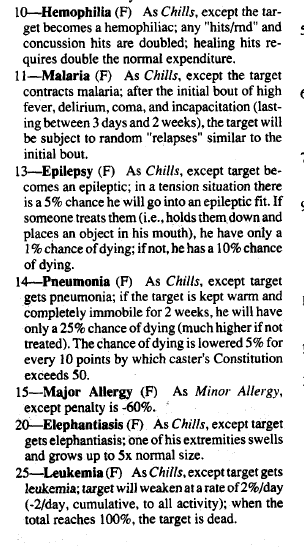
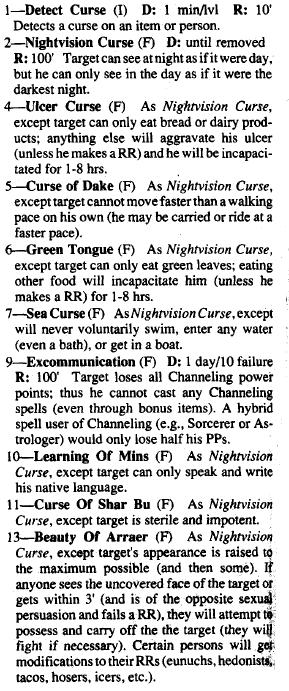
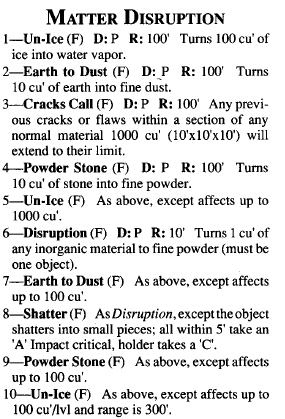
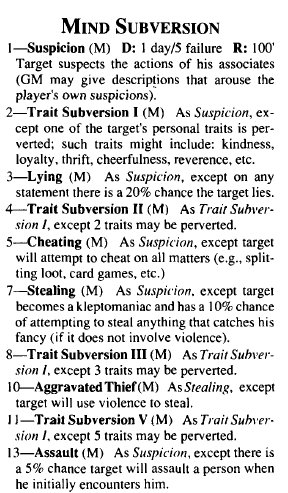
Specifically evil!
To cast a spell, the caster first determines which class the spell will fall into.
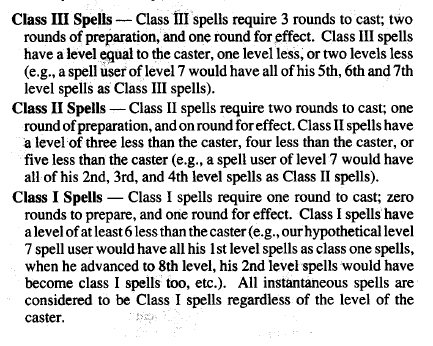
As you can see, it takes a long time to cast a spell, and you need to get to a pretty high level before you can start tossing off spells. Even then, it still takes a full round for the spell to go off, giving everyone else in combat a chance to tag you and interrupt your casting. The noted exception, instant spells, are almost always defensive spells like Deflection, Aim Untrue and Bladeturn, or movement based spells like Leaping or Balance. None of them are attack spells.
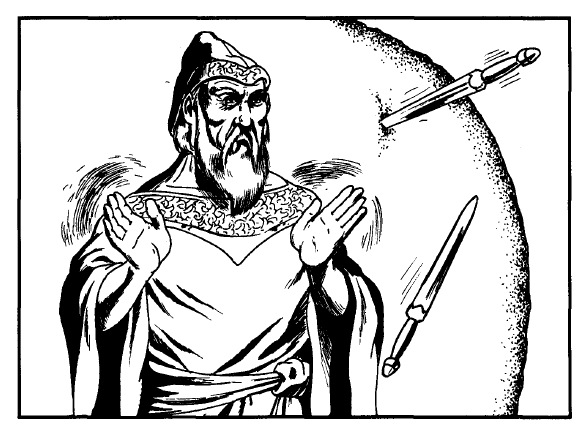
Aim Untrue, arguably the most important spell in the game, makes any one ranged attack in the caster’s field of vision automatically miss. I like to imagine the verbal component goes “Nuh uh.”
Let’s take a look at a sample spell list to see how well this is going to work out. We’ll look at one of the Magician’s base lists, as the Magician is the most basic of the casters and considered a pretty flexible combatant:

As you can see, he begins the game being able to spend three rounds boiling water, and can advance to the more useful heating of swords and lighting of buildings on fire. He doesn’t get a fireball spell until level 6, and even then, it will take three full rounds of combat before it goes off, giving the fighters and rogues ample time to clear the battlefield. In the interests of full disclosure, the Magician does get a small lightning bolt spell at level 2 if they learn the list “Light Law,” but until they reach level 5, again, it’s taking 3 rounds to get off, and then it’s 2 until they hit 8.
There are also number of casting classes that don’t have any combat capabilities at all. The Astrologer, for example, does a lot of long range scrying, telling fortunes, and detection. The Alchemist can create items and imbed spells. They seem like they could be neat, and in a pinch you could always rely on the somewhat combat oriented lists in the closed and open lists, like Spirit mastery, or just hang back and take pot shots with a crossbow.
But wait, I can hear you saying, why is that a bad thing? Delayed gratification and creative thinking should be the highlight of the role playing experience, shouldn’t they? To explain that, we’ll need to briefly touch on XP, which I wasn’t going to go into in depth until part 5. But for now, you only need to know two things: 1, the majority of XP comes from killing things, and 2, only the person who kills the thing gets XP for the kill. This simple oversight manages to invalidate the majority of the interesting non-combat oriented classes, because they’ll never advance at the same rate as the killing PCs. They are, quite frankly, a Trap.
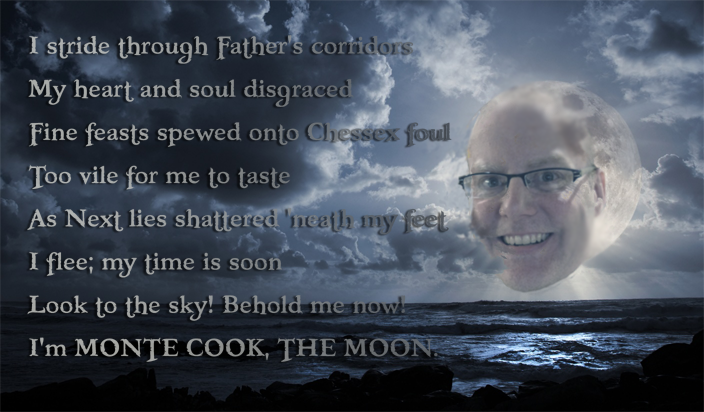
(In the interests of full disclosure, this isn’t the Moon’s fault. He didn’t sign on with the Rolemaster crew until 1989, working on Creatures and Treasures II , and the Rolemaster Companions 4-7. The problem existed before he was there, but it plays out just like in his famous essay on Ivory Tower game design. Since you can take these caster’s base lists as another profession if you can find their tomes at a cost of 3* on a pure caster (a common house rule which is actually presented in Spell Law itself), there’s no reason to ever actually play one.)
So, let’s make some casters! I’m not going to go through the process in depth like we did with Diana, merely going to present the characters with notes on how and why I’d build them the way I did.
AmiYumi posted:
Hipster Elf Scholar, who was into everything you like before you were even born
Dr. Romelle Dregolas, MA, PhD, M.D., DDS, FRAS, FGAR, is a highly trained elven scholar, who knows everything there is to know about everything. Certainly more than you, anyways. He is a level 1 High Elf Sage.
The Scholar class from RMC2 is a neat idea, a non-combat oriented class that gets all the academic skills at a pretty good discount. Unfortunately, it is 100% overshadowed by the Sage, a mentalism caster from that exact same book, which has almost 1-for-1 costs on its skills as well as a host of spell lists that help it magically identify and know things. The reduced Rogue skills that the scholar gets will be overshadowed by the invisibility and telekinetic spells that the Sage will be able to pick up. In the end, though, neither will end up being a great idea. We'll understand why later.
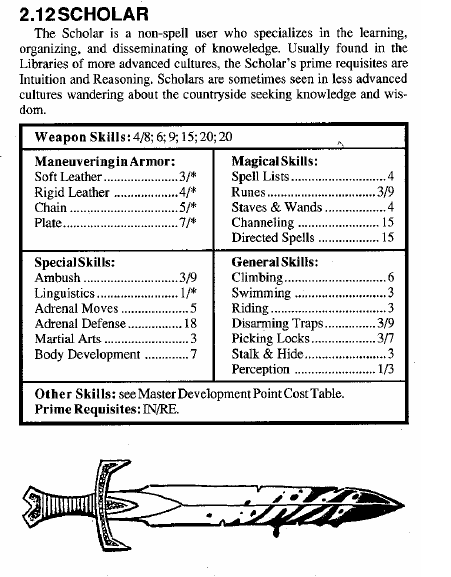
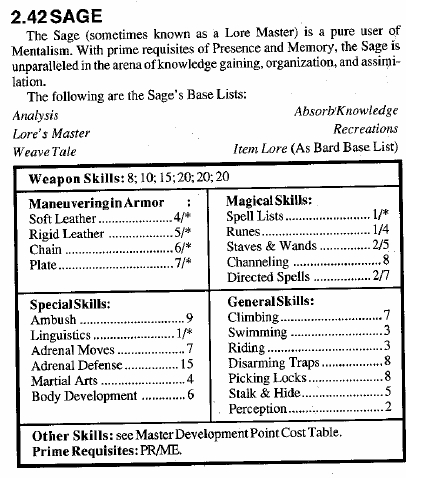
I imagine the sword is bloody from the Sage stabbing the Scholar in the back and stealing his role in the game
His spells allow him to store any scene he is in for recreation with a spell 5 levels later in the list, which will be useful if he is ever needs to recreate the scene of a crime or even if he just wants to spruce up his camping tent, read texts in any language, but only get the basic jist of them, gain a permanent +20 to his RE bonus, and learn anything he reads or sees as if he had a photographic memory. This will be great if there is any mystery or exploration aspect to the game, but could also end up being completely useless if its a more hack n’ slash game. He can also talk in a hypnotic, droning manner that soothes all the listeners into a passive calm, which will be good for keeping him safe if he doesn't run into anyone with good mental defenses. Just in case, though, he paid his 8 DPs for a single rank in longbow, as what Elf in his right mind doesn’t know his way around one?
Dr. Dregolas will be the smartest character at the table, in any case.
Plague of Hats posted:
It's unfair since I know what's up, but I really want you to make aHobbitHalfling Layman who is super into casting spells.
Gilbo Saggins, general lay about and farmer’s son, stumbled onto the wizard’s spellbook at the county fair one day, and whether through luck or coincidence, knocked all the milk jugs over with the wooden ball enough times to take home his prize. With a few months of study, he mastered the rudiments of the magickal arts, and is now a level 1 Halfling Farmer.
The farmer class is a variant on the fighter that gets some pretty boss discounts on agricultural skills in exchange for some of its fighting prowess and ease at wearing armor. It pays 20 DPs per rank of Spell List Acquisition. Non-casters can learn the Open spell lists of any one realm from 1-5, and no further.
Looking at Mr. Saggins essence casting stat, Empathy, we find that he has a 91, which is pretty high (+11 bonus). He buys a rank in one of the spell lists from his book, which costs about 1/3rd of his total DPs at character creation, and gives him a +5 to his SLA roll. Hobbits get a -5 to EM, so his EM bonus is currently a 6. Adding the 5 from his skill rank, he has a total of 11. He’d need to roll a 90 on a d100 to acquire the first 5 spells on the list.
When compared to Dr. Dregolas up there, who had a 99 in his PR (the mentalism casting stat), which is a +23 bonus, an extra +10 from being a high elf, and a +15 from the 3 ranks he was able to easily afford as his SLA only costs him 1 DP per rank, at each level the good Doctor has to roll a 53 or more to get the list he has put points into, a much better chance at a much cheaper cost.
With a chances at level 0 and level 1 during creation, Romelle easily gets 6 of his 10 base lists, a little more than half, while Gilbo ends up not hitting either of his 10% shots.
Comrade Koba posted:
Runebeard the Resplendent, dwarf master wizard.
wdarkk posted:
Make a dude who summons monsters to fight for him because fuck getting his hands dirty. That shit is beneath him.
Corpulent Conjurer Dupree Duquesne, of the Resplendent Runebeards, dreamed of the day when his demonic devotees and elemental allies would wait on him hand and foot, fulfilling his every request and tearing those who oppose him to shreds. No more toiling in the mines like his father, and his father before him! That shit is tiring! He is a level 1 dwarf conjurer.
Unfortunately, it’ll be a while before he can actually summon more than his cat familiar and the demonic raven that it constantly tries to eat. He can spend a minute drawing 1 foot radius magical circles of power on the ground which will cause anyone crossing into them to fall asleep or will keep animals away, which will be great for protecting the party at night if they can find a room with a narrow doorway, and which will be much more useful once he gains a few more levels and can expand that radius (it grows up to 1’ per level, but takes 1 minute per foot to draw). He can also identify any spirit he comes into contact with, but cannot do anything to it yet.
If he can get to level 2, he can start summoning animals, and monsters and demons as he gets higher and higher. Until then, he’ll have to rely on his dwarven crossbow to take things out, because unfortunately, cats aren't nearly as lethal to commoners as they are in D&D.
Xelkelvos posted:
An Orcish jester/clown, trained to beguile or bemuse his opponents while entertaining, invigorating and sometimes enraging his allies
Humbug Scoolbus posted:
A Half-Orc Barmaid Warrior Monk that was raised by Hobbits on a fishing boat.
Scribda the Unweidly is a Half-Orc monk, a semi spell caster of the realm of essence, mistress of the martial arts and fisherwoman extraordinate. Though she dresses like an oversized hobbit and acts like a country fishwife, her demeanor changes the moment she enters combat, the rolling gait suddenly an unhittable bob and weave, the bumbling shuffle a blindingly fast dash, the arms which spin to keep her balance slamming like a hammer driving stakes.
All her spell lists have to do with movement, dodging and jumping, supernatural senses, or self-healing. She can leap 10’ into the air to swing from chandeliers and branches, hear things twice as well as a normal half-orc, add 50 to any roll involving balance, stop herself from bleeding by concentrating and standing still, and leap either 50’ horizontally or 20’ vertically instantly. She also takes ranks in martial arts, which gives her access to a special set of critical charts that we will cover in the next section on combat.
Next Time : Combat! or, Yes, that picture with the pile of hacked off limbs is pretty accurate...
Combat! Starring Rick Jason and Vic Morrow.
Original SA post
Rolemaster: Part 4 - Combat! Starring Rick Jason and Vic Morrow.
First off, let’s start this off right, with more 80s metal.
http://www.youtube.com/watch?v=-4qTi7cDtI4
Yeah! That’s chart referencing and percentage calculating music!
Now, combat in Rolemaster is either pretty straightforward, or the worst joke you’ve ever heard about how stupidly specific D&D gets with its charts. Don’t believe me? Here’s a guide to calculating how different sub-use scabbard materials and placement affects your initiative when drawing your sword, and how to calculate the cost of a multipurpose sheath:
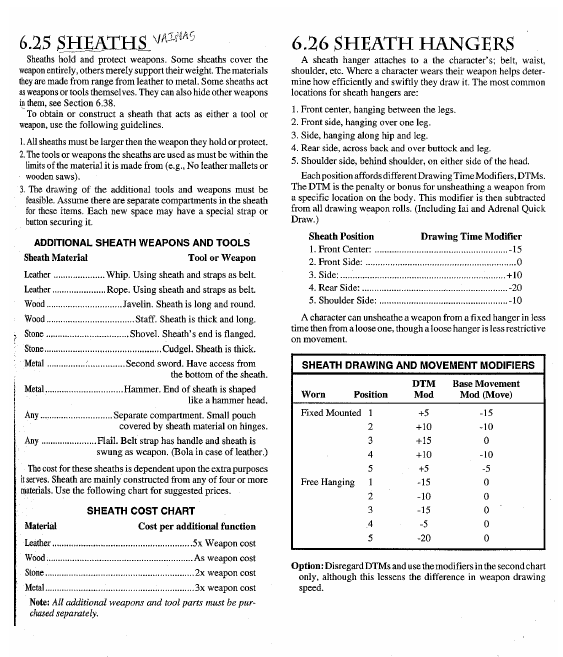
A shovel sheath cannot be made of anything but stone! So sayeth the ICE gods!
You can’t make this shit up!
See, the simulationist
 lords at ICE had a very bad habit of simply publishing anything and everything that was sent to them with only the most cursory glance as to whether it was something anyone would ever need, let alone whether or not it affected game balance, simply labeling just about everything in the game “optional” and leaving it up to the GM to make calls as to what did and didn’t fly in their games. IYears before White Wolf started published books that were chockful of “secret and mysterious” clans and sects that you would never, ever get to play despite having full rules and write ups for them, Rolemaster was leading the charge! It helped insure that if you played at two different tables playing Rolemaster, you had no idea what the game would actually be like!
lords at ICE had a very bad habit of simply publishing anything and everything that was sent to them with only the most cursory glance as to whether it was something anyone would ever need, let alone whether or not it affected game balance, simply labeling just about everything in the game “optional” and leaving it up to the GM to make calls as to what did and didn’t fly in their games. IYears before White Wolf started published books that were chockful of “secret and mysterious” clans and sects that you would never, ever get to play despite having full rules and write ups for them, Rolemaster was leading the charge! It helped insure that if you played at two different tables playing Rolemaster, you had no idea what the game would actually be like!
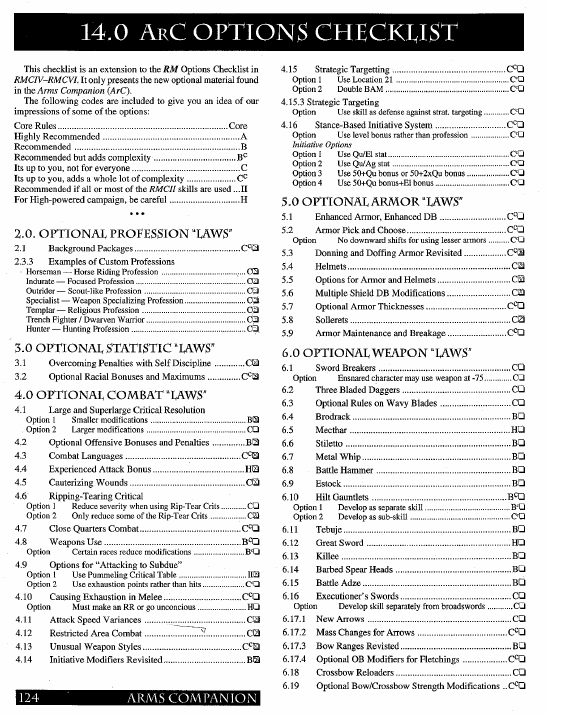
The later books started including checklists in the back so you could keep track of which optional rules you were using, and which ones they recommended you actually use. But if you can think of it, there’s probably a rule or a chart for it somewhere.
But, by ignoring all that optional crap, you have a combat system that runs pretty smoothly once everyone gets the hang of it, and does a very nice job of being more “realistic” than D&D without going full on FATAL with nonsense about HP for individual limbs and such.
Combat is divided into 4 broad phases:
1. Magic
2. Missile
3. Movement
4. Melee
Everyone acts at the same time, and initiative is only rolled if there is a dispute. This is a rule I dig because it prevents the “everyone sits around while Jimmy is an indecisive waffle about which of the three orcs he wants to hit” that the turn by turn initiative systems most games from this period have. While Jim overthinks, we can resolve the other people at the table who know what they want to do.
The phases are technically a little more complicated than that, with, for example, the magic phase broken up by the Spell Action phase and Spell Results phase and Spell Orientation phase all being rolled up into one phase up above because it so rarely comes up that they aren’t all one unit that it doesn’t really matter.
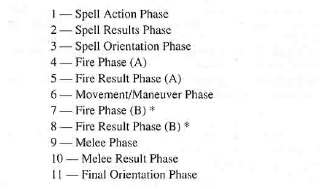
The fancy dan overly complicated version
The phases are pretty self explanatory: magic is cast in the spell phase, missile weapons are fired in the missile phase, etc. You can take an “opportunity action” to go take the action of an earlier phase in a later one (if you want to move to a different position before you use your bow, for example), but you cannot jump ahead. Melee tends to be the only one that gets a lot of initiative rolls, which are a d100 + your Quickness bonus, but occasionally missile will get them as well for sniper duels and such.
Each action a character takes during a round takes a various percentage, with the lowest at 10% being things like “casting your first instant spell this round” and “Moving at a slow walk (1/2 base rate)”, and the largest at 90% being things like “performing multiple martial arts attacks” “reloading a crossbow” and “Sprinting at x4 base movement”. For the most part, you won’t end up using the whole 100%, unless you’ve got a spell or a magic item like Haste or Speed which doubles your actions, and will allow you to make multiple attacks (which are 70%).
The rough version is you’ve got enough to move your regular speed (20%), make an attack or begin casting a non-instant spell (70%), and 10% left over for talking or signaling to other PCs.
These action percentages are difficult as hell to find, spread throughout multiple books. I was lucky enough to have a GM who compiled them all into a handout for us, otherwise it’d be hell.
The game doesn’t come out and say it, but you’re going to use a hex grid with 5 or 10 foot hexes, and miniatures. Combat is crunchy enough about ranges, flanking, and other tactical considerations that Theatre of the Mind play would be pretty darn tricky. In fact, I’d say that Rolemaster is about as close to a computer game as you’re going to get without an actual computer. More on this in a moment.
There are four important statistics for each combatant during combat, their Offensive Bonus (OB) and their Defensive Bonus (DB), which determine hits and misses, their Hit Points, which you already know about because this isn’t your first rodeo, and their Armor Type, which is an interesting variation on armor class that I haven’t seen in any other games.
Rather than have armor work as a combined “luck + hits that don’t hurt + divine grace + rolling with the hit” thing like D&D, what Armor Type you are in explicitly effects what amount of damage each type of weapon does to you and what kind of criticals will be inflicted. As you’ll see in a moment, the heavier armors result in you getting hit more often, but with far fewer criticals being inflicted, and that it’s way better to wear almost nothing if you’re not going to wear AT9 or higher. This is an interesting way to represent the protective capabilities of armor, and not a completely inaccurate one; heavier armor can be bulkier, but the mail and plate take most of the hit for you, while bare skin just gets torn to shreds. As a house rule, we play that the Plate base armors drop criticals one severity, because the maneuver penalties they inflict are so severe and not exactly based in reality (the game for all its vaunted research being made in the 80s, back before a lot of proper study was done into the actual wearing of armor for practical use) that otherwise it’s overall better to wear a Teddy Roosevelt style AT12 leather hunting suit than a suit of plate mail. Cool as that suit is, sometimes you want to play a knight in shining armor, and giving them a tankier bonus seemed a good way to cut the difference.
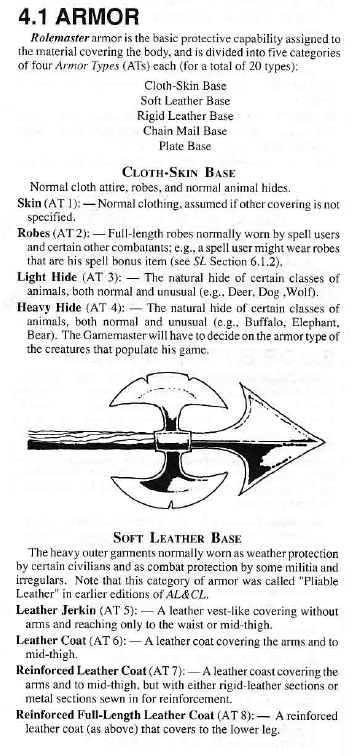
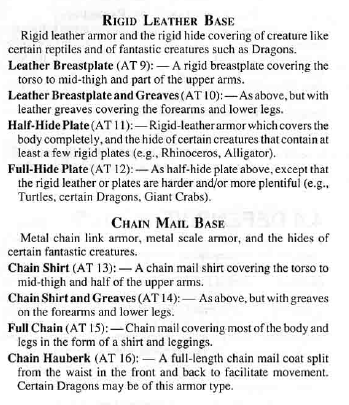
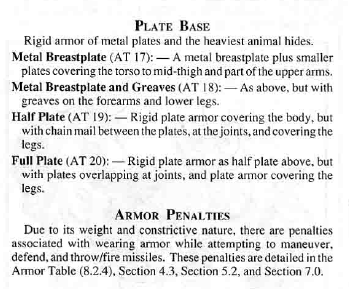
Because there are only 4 important numbers, this makes the GMs job pretty easy, as you can just make a column with the various numbers for each monster, noting which type of weapon each OB is for and which type of critical is inflicts (more on this in a moment), a couple notes about what the thing is carrying and if it has any magical spells, and you’re all done.

Sample bad guy entries from Rolemaster Companion VII
To calculate the Player’s OB, you take the total of their relevant weapon or martial arts skill, add in any bonuses from magical weapons or ammunition, backgrounds, circumstances, etc.
To calculate the Player’s DB, you take their quickness bonus, add any relevant magical items or backgrounds, and any ranks they might have in the (usually obscenely expensive) skill Adrenal Dodge. You also get a +10 to +30 bonus if you are carrying a shield, depending on the shield.
What this means is that while people’s OB quickly skyrockets, the DBs are usually quite low. This is because, simulationists that they are, ICE isn’t really in favor of people being innately superfast and unhittable. This is where Parrying comes in. You are allowed to sack part of your OB and apply it to your DB, to represent actively defending yourself against an attacker. Thankfully, you are always allowed to declare a parry regardless of how well you did on initative in the melee phase, though if you parry with 50% or more of your OB, you automatically secede initative to your opponent. You can also do a “full parry” and apply your entire OB to your DB, if you’re nervous about the enemy attacking you. Against bows, well, you’re fucked. Better hope there’s a mage in range with an Aim Untrue, or that you can get your hands on a magical item that casts it quickly.
To make an attack, the attacker rolls a d100, adds it to their OB, and tells the GM. The GM then adds in any modifiers for positioning (you get a bonus for a back attack, for example), subtracts the defenders DB from the number, and consults the weapon’s chart.
Each weapon has a big chart that looks like this:
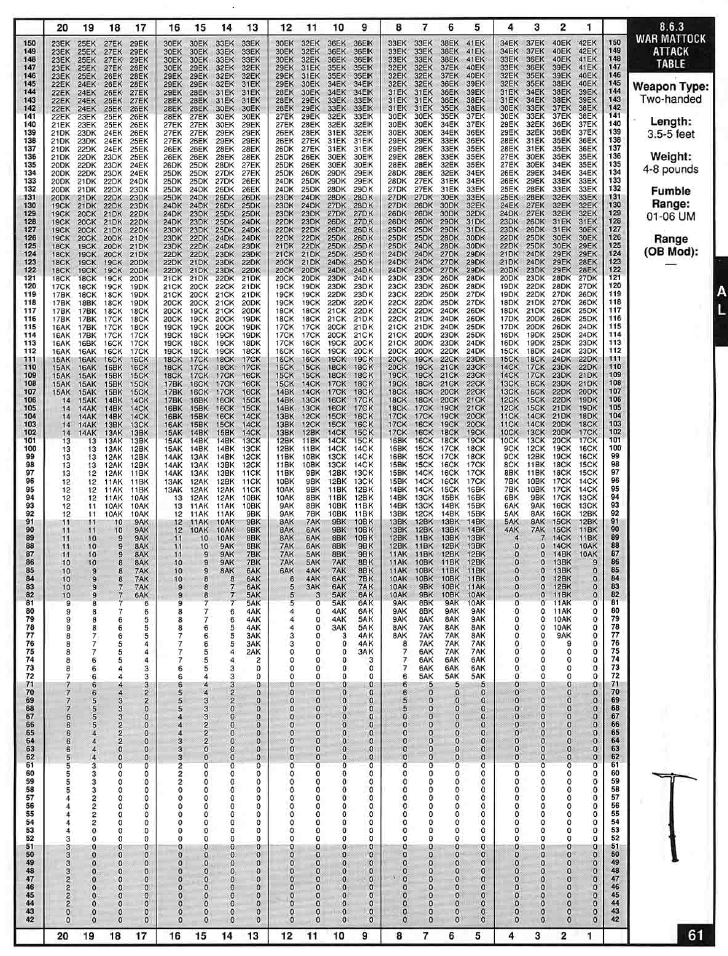
Only complicated til you know how to read it
You slide across the top to find what armor type the defender is in, then slide downwards to find the result of the attacker’s OB minus the defender’s DB just calculated a moment ago. The number there is how much “concussion damage” is given as a result of the strike, hit point damage. The two letter code, if present, is the critical severity (first letter) and its type (second letter). The critical severity range from A-E, with A being the weakest and E the most lethal. The most common types of criticals are Slashes (S), Pierces (P), and Krushes (K, so used to distinguish them from the C severity). The player rolls on the critical chart to determine the fate of the foe, or vice versa.
This is Rolemaster’s claim to fame, and ICE’s famous tag line “The Inventors of the Critical Hit”. Arms Law/Claw Law actually came out years before Rolemaster did, and was intended as an add on supplement to AD&D or any other roleplaying game system that wanted a more “realistic” combat system. And since when you get hit with a sword, you get cut in the arm and start bleeding, or you get poked in the eye and permanently lose vision on that side, rather than taking an abstract number of hits off of an abstract value representing how lucky, rough and tumble, good with armor, and divinely protected you are, this book launched a hundred crit charts depicting horrific things that occurred to you if the DM rolled a natural 20.
In Rolemaster, though, the crits are on a sliding scale, as we mentioned above, and aren’t all instant death and disfigurement. Just a lot of them.
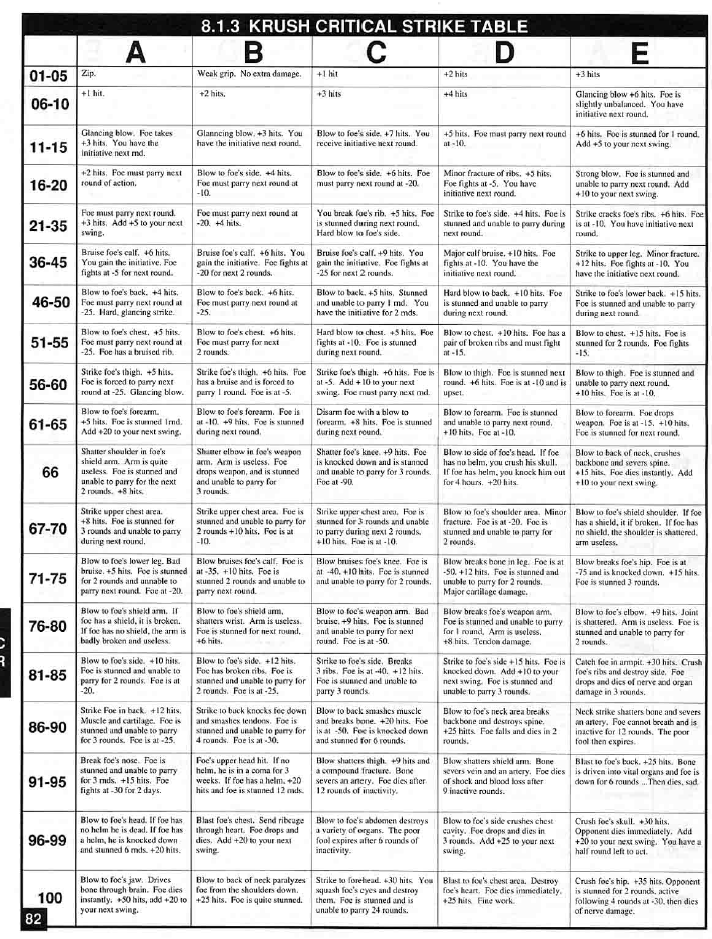
So, if our hypothetical fighter hits someone with his war mattock, which only does Krush criticals, depending on how well he hits him and how lucky he is on his critical roll, he can do anything from nothing at all, to instantly killing him. Most likely, he will do a little extra damage, stun the defender, and force them to full parry next round. But the harder he hit, the more sever the critical, and the E column is a lot deadlier than the A one is, and inflicts more severe penalties even when it doesn’t kill outright.
Is this trickier than just rolling once for attack and once for damage? A little, sure. But not that much. It’s actually not all that different from the kind of thing that a computer game from the period might do, taking into account all your fiddly little bonuses and comparing them with the armor of the enemy.
You might also note that the weapon chart “tops out” at 150. That’s right, there’s a bounded limit for how much you can fuck someone up with a given weapon, even if you roll triple open ended and have a +300 skill in swords. This is because you really ought to be parrying, and because you can split your attack once you have a sufficiently high OB to do so. To split your attack, before you roll the dice, you divide the OB number, subtract 20 from each side, and make two attacks. This is silly if you only have only 100 OB, because you’ll be attacking two targets at a net of 30 ((100/2)-20=30), but not so bad if you’ve got a 300 OB and you’re fighting piddly little things ((300/2)-20=130). The game gets complicated , but it’s mostly just a bit of basic math. If you do it once or twice, you end up writing down the numbers for your common split attacks and parries, and won’t even have to touch a calculator.
Now, if you play with all the optional rules, where everyone has a billion fiddly little bonuses to everything, and there are sixteen different charts you need to consult before you take any action, it becomes a horrific slog. But the worst my group has ever had was waiting a moment for the GM to pull out the radiation critical charts from a different book that he hadn’t compiled into his One Big Book of Critical Charts yet. Is this a failure of the game? Totally. As the different companions came out, the need to flip between three or four different books grew and the game got crazy. But with a little photocopying and some plastic sheets, my GM made his own books in a sensible order so he could run the game smoothly. It is of absolutely no surprise that this isn’t worth the time and effort to everyone else. But there are a lot of neat ideas and concepts that could be stolen and incorporated into other games.
Next Time: Sample Combat! or, how many of those level 1 guys we made last time will survive their first encounter?